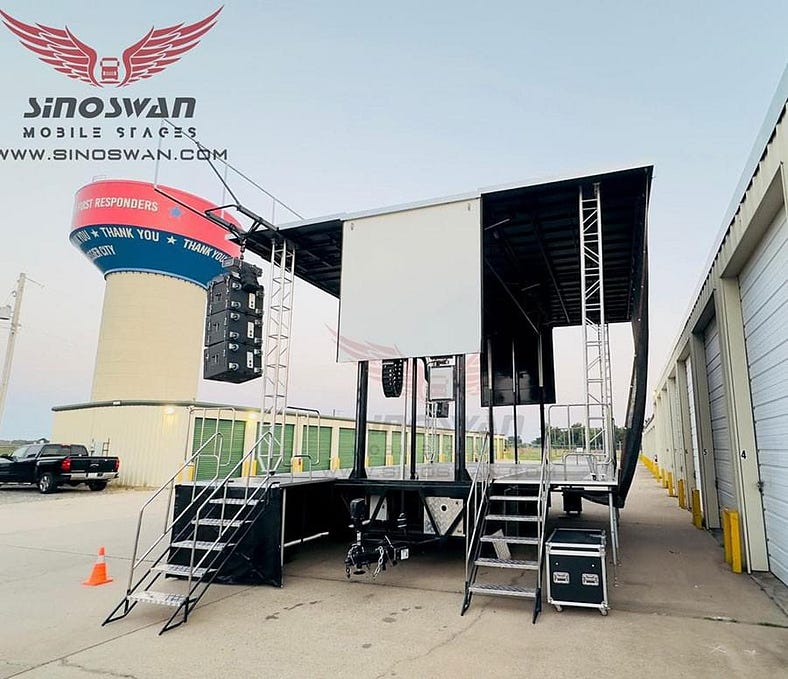How Live Broadcast Vehicles are Transforming Remote Media Coverage
Sinoswan’s mobile broadcast studios and live broadcast vehicles are not merely equipment but also the facilitators of the new forms of journalism, immersive narration, and present-time interaction.

In this era of highly mobile media, the need for on-the-ground coverage has never been higher. Whether it is from a live sports event, breaking news, remote interviews, or outdoor entertainment shows, viewers want a smooth flow of information through real-time delivery. The core of this evolution is live broadcast vehicles and mobile broadcast studios, marvels of technology that can bring the studio to the field, allowing high-level broadcasting at almost any site.
What is Live Broadcast Vehicle?
A live transmission truck, called an Outside Broadcasting (OB) truck or Satellite News Gathering (SNG) truck, is a travelling studio with the equipment required to transmit audio-visual concurrently. These automobiles act as a nerve center in terms of recording live events, processing, and transmitting. In contrast to conventional studies, the OB vans can be constructed to work in distant locations or dynamic conditions, without the need to lower the broadcast standard; rather, they would be flexible.
Contemporary broadcasting vehicles are equipped with high-definition cameras, audio mixing consoles, video switches, uplinks, 5G/4G bonding, and very often, drones to capture aerial shots. With such enhanced features, the OB vans can be easily put in place at a spot, achieve communication with the main studio, and start running in a few minutes.
Specifications of a Mobile Broadcast Studio
A mobile broadcast studio takes the concept of an OB van to another level because it is a production studio on wheels. Units may be built to order, fitted out within large vehicles- buses, trailers, or trucks, multiple camera inputs, editing suites, lighting rigs, chroma key (green screen) facilities, satellite communication gear, and even soundproof booths to record voiceovers or interviews.
Mobile studios are ergonomically- and performance-built. Superior grade ventilation, acoustical insulation, and ongoing power services allow crews to work under varied settings, be it a desert-based rally or a mountain-based documentary. Such studios are future-proof concerning broadcast needs as they accommodate varying formats, including SD to 4K, as well as 8K.
Use Cases: News to Entertainment
Live broadcast vehicles and mobile studios can be found in a wide range of industries:
1. Breaking News and Disaster Reporting
The media organizations use the OB vans during the news stories on natural disasters, political conflict, or political elections. Its capacity to deploy quickly and relay real-time updates gives people in the audience situational awareness in real-time.
2. Live and Sports
Multi-camera mobile studios enable broadcasters to film sports events, concerts, and festivals with a cinema-like quality. The arrangement incorporates slow-motion replays, multi-angle replays, and commentary in real time, all of which are processed locally.
3. Government Use and Corporate Use
Companies are using broadcast units on the move to stream AGMs, product releases, or internal notices. They are utilized by government bodies in response to disasters in order to broadcast messages to the public and provide safe live feeds.
4. Learning and Virtual Events
Since educational organisations have embraced remote learning and frequent virtual conferences, mobile studios have become an effective tool to deliver interactive content that is not as impersonal as a normal video call.
Technology Integration: 5G, IP, and Cloud Broadcasting
The recent mobile broadcasting structure is becoming accustomed to ultramodern technologies. Integration of 5G features enables clearances of the lowest latency up to streaming of live sports events and multi-site synchronisation. The use of IP-based broadcasting allows connectivity and routing to be simplified and allows remote production teams to place control of cameras or switch feeds back to HQ. Cloud broadcasting means editing and uploading to social media in real time, an invaluable benefit to news teams pursuing digital-first strategies.
Besides, AI-based solutions are being introduced to provide real-time translation, face detection, and automatic captioning- further improving both accessibility and reach.
Conclusion
Sinoswan’s mobile broadcast studios and live broadcast vehicles are not merely equipment but also the facilitators of the new forms of journalism, immersive narration, and present-time interaction. They embody both mobility and connectivity as well as creativity. With the pace of increasing demand for live, quality-oriented content delivery in any industry, investment in mobile broadcasting capabilities will leave a considerable edge in terms of competitive advantage in the attention economy.
Contact Details:
- Website: Sinoswan
- Email: info@sinoswan.com
- Tel: +8618538129701
- WhatsApp Business: +8618838950310
- WhatsApp: +8618637178390
- WeChat: +86 18538129701
- YouTube: Sinoswan on YouTube
- Visit : Alibaba